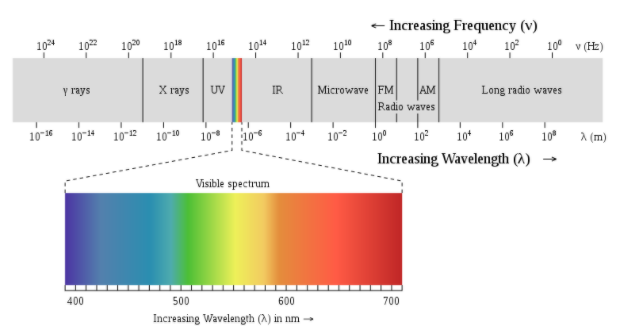
Indigo and Red regions of VIBGYOR, respectively fall in range of wavelength?
A.
B.
C.
D.
Answer
478.2k+ views
Hint: VIBGYOR contains seven colours. Violet exhibits the shortest wavelength whereas red has the longest one. These colours come under the visible spectrum starting from the wavelength
Complete answer:
-VIBGYOR stands for colours that we can observe in the rainbow-
V stand for Violet (wavelength
I stand for Indigo (wavelength
B stands for Blue (wavelength
G stand for Green (wavelength
Y stands for Yellow (wavelength
O stand for Orange (wavelength
R stands for Red (wavelength
-When all of the colours are combined, we get white light that we can see coming from the sun or a light source.
-Red colour exhibits the longest wavelength while Violet colour exhibits the shortest one.
-The wavelength that reflects our eyes, tells us the colour of an object.
-Our eyes can only detect the visible region of the electromagnetic spectrum. Depending on the wavelength, we can differentiate between different colours.
-Red colour can be detected if the wavelength is
-Light is also called “Polychromatic” because it is a mixture of all of the colours known as “VIBGYOR”.
-On the other hand, lasers are ‘monochromatic’ light and contain the light of only one wavelength and can cause severe damage to our eyes.
-The colours that the object’s molecules reflect, tell us the colour of the object. For example, an apple is red because the molecules of the apple absorb all other colours except the colour “red”. Same goes for the green t-shirt your friend is wearing or the blackboard (black absorbs all of the colours and reflects no colour so it’s black).
-Our eyes are capable of perceiving colours because they contain photoreceptors known as rods and cones. Rods are responsible for white, grey and black colour perception while cones are responsible to receive other colours.

Hence, the correct answer is option (A).
Note: The electromagnetic radiation spectra depict different types of radiations or waves which differ in the matter of their wavelengths and their intensity. There is a small portion of the spectra that is visible to our eyes and that spectrum is known as “Visible Range” because our eyes can perceive that part of the spectrum. The intensity of the colour can be explained with the example - the low-intensity yellow-orange is seen as brown and a low-intensity yellow-green can be referred to as the olive green colour.
Complete answer:
-VIBGYOR stands for colours that we can observe in the rainbow-
V stand for Violet (wavelength
I stand for Indigo (wavelength
B stands for Blue (wavelength
G stand for Green (wavelength
Y stands for Yellow (wavelength
O stand for Orange (wavelength
R stands for Red (wavelength
-When all of the colours are combined, we get white light that we can see coming from the sun or a light source.
-Red colour exhibits the longest wavelength while Violet colour exhibits the shortest one.
-The wavelength that reflects our eyes, tells us the colour of an object.
-Our eyes can only detect the visible region of the electromagnetic spectrum. Depending on the wavelength, we can differentiate between different colours.
-Red colour can be detected if the wavelength is
-Light is also called “Polychromatic” because it is a mixture of all of the colours known as “VIBGYOR”.
-On the other hand, lasers are ‘monochromatic’ light and contain the light of only one wavelength and can cause severe damage to our eyes.
-The colours that the object’s molecules reflect, tell us the colour of the object. For example, an apple is red because the molecules of the apple absorb all other colours except the colour “red”. Same goes for the green t-shirt your friend is wearing or the blackboard (black absorbs all of the colours and reflects no colour so it’s black).
-Our eyes are capable of perceiving colours because they contain photoreceptors known as rods and cones. Rods are responsible for white, grey and black colour perception while cones are responsible to receive other colours.

Hence, the correct answer is option (A).
Note: The electromagnetic radiation spectra depict different types of radiations or waves which differ in the matter of their wavelengths and their intensity. There is a small portion of the spectra that is visible to our eyes and that spectrum is known as “Visible Range” because our eyes can perceive that part of the spectrum. The intensity of the colour can be explained with the example - the low-intensity yellow-orange is seen as brown and a low-intensity yellow-green can be referred to as the olive green colour.
Recently Updated Pages
Master Class 10 Science: Engaging Questions & Answers for Success

Master Class 10 Social Science: Engaging Questions & Answers for Success

Master Class 10 Maths: Engaging Questions & Answers for Success

Master Class 10 English: Engaging Questions & Answers for Success

Class 10 Question and Answer - Your Ultimate Solutions Guide

Master Class 9 General Knowledge: Engaging Questions & Answers for Success

Trending doubts
State and prove Bernoullis theorem class 11 physics CBSE

1 ton equals to A 100 kg B 1000 kg C 10 kg D 10000 class 11 physics CBSE

State the laws of reflection of light

One Metric ton is equal to kg A 10000 B 1000 C 100 class 11 physics CBSE

Difference Between Prokaryotic Cells and Eukaryotic Cells

1 Quintal is equal to a 110 kg b 10 kg c 100kg d 1000 class 11 physics CBSE




